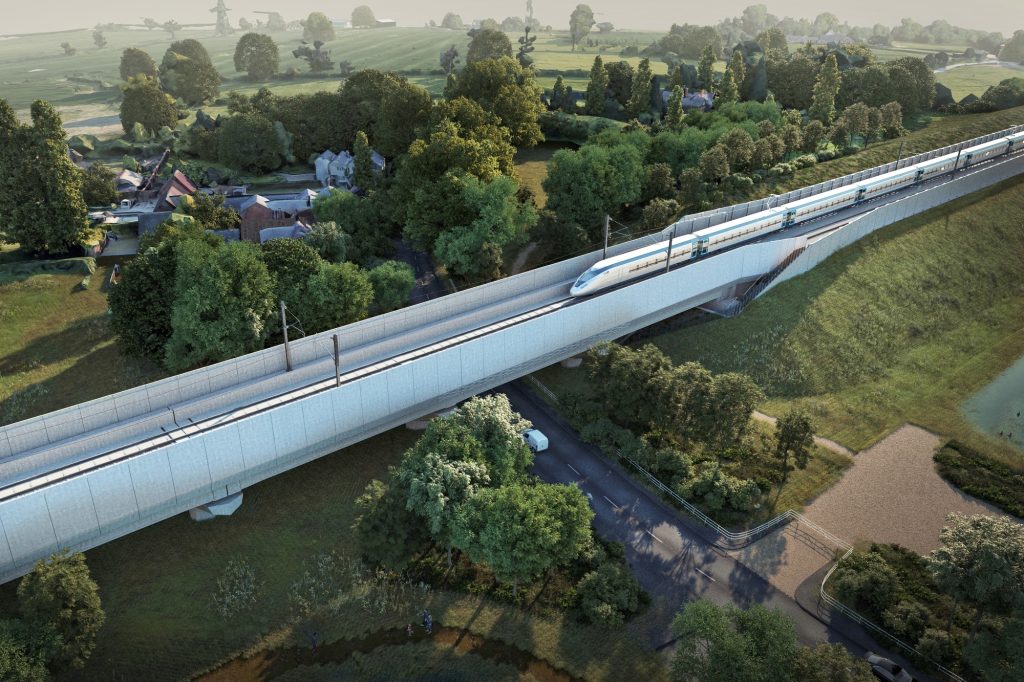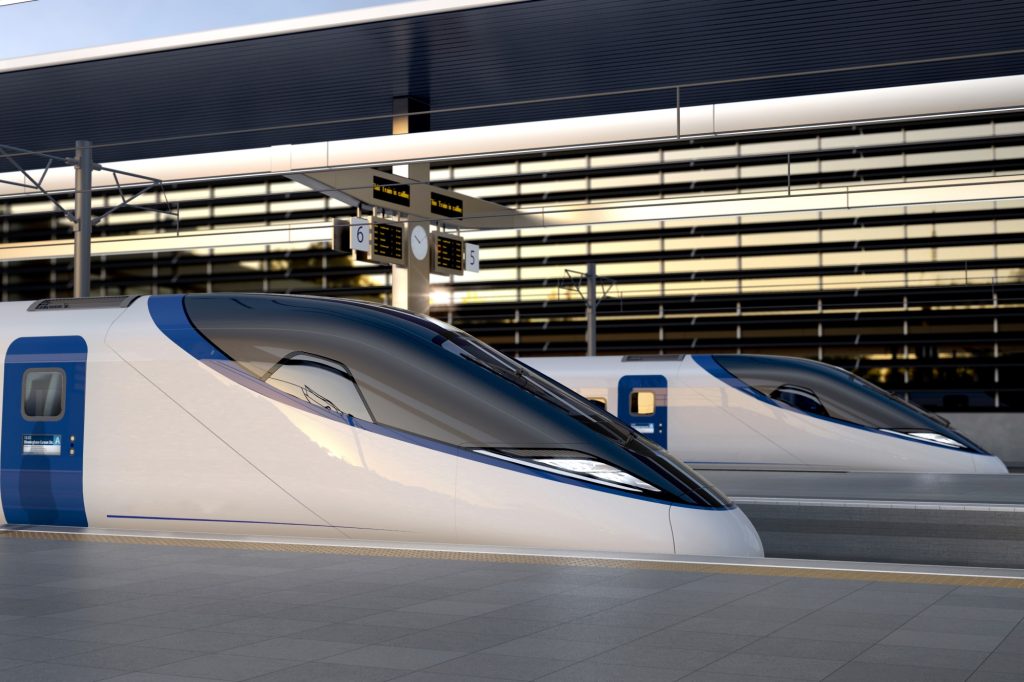HS2 reveals plans and delivery targets for coming years

This post was originally published on this site

HS2 Ltd has released its HS2 Corporate Plan 2022 to 2026, providing an overview of its goals for High Speed 2 (HS2) beyond the mid-decade mark.
Construction of key routes and stations is scheduled to go ahead, while HS2 East connecting Birmingham in the West Midlands to the East Midlands is on the agenda, despite indications earlier this year that it could be shelved or delayed to cut costs.
The opening statement of the 76-page document from HS2 Ltd chairman Sir Jon Thompson cites inflationary cost pressures as a key factor affecting HS2. This has necessitated the re-phasing key of parts of the scheme.
Thompson said: “The significant rise in construction costs means businesses throughout our supply chain are struggling to meet the commitments they made just a few years ago.
“Rephasing delivery of some parts of the programme until those pressures are less severe will help us do this without jeopardising the transformational benefits this once-in-a-lifetime project provides.”
However, many ongoing and planned elements of the scheme remain on track.
Phase 1
Fradley, Staffordshire to Long Itchington Wood, Warwickshire: BBV
In the Birmingham area of Phase One main works, delivered by contractor BBV (Balfour Beatty Vinci JV), HS2 Ltd predicts an expected 80% increase in activity this year. This is despite the rephasing of some planned activities between Curdworth in North Warwickshire and Handsacre in Staffordshire to manage cost pressures.
HS2 Ltd confirmed BBV will continue as planned with works that are underway and affect major assets like critical utilities, A-roads, motorways and the conventional rail network.
Works around the A38 at Streethay and works to create a box bridge underneath the West Coast Main Line, near Lichfield Trent Valley, are unaffected by the rephasing.
BBV’s route section will require major earthworks, including embankments and cuttings, to form the level ground we need for HS2.
At the Birmingham Curzon Street station site, work is underway to construct the first deck span of the viaduct that will take trains into the station. This will sit on the specially-designed V-shaped piers.
Following the completion of the second drive for the Long Itchington Wood tunnel in March, BBV has started building a cut-and-cover tunnel near the southern portal. The 17m structure will further help the railway to blend into the landscape and is due to be completed by the end of 2025.
BBV completed the 200m “porous portal” for its Burton Green Tunnel in April and the team are now focused on completing the rest of the 700m tunnel. The process of excavating a cutting, building the diaphragm walls to support the tunnel, adding a concrete roof and backfilling it with soil ready for planting will take up to four years.
Long Itchington Wood to the Chiltern tunnel: EKFB
Work has also continued on the Long Itchington Wood to Chiltern tunnel section of the route, which is being constructed by EKFB (Eiffage, Kier, Ferrovial, Bam Nuttall JV). EKFB has been preparing the ground for 81 bridges, 15 viaducts and three green tunnels that will take high-speed trains through the heart of England.
This year, it will start building several of the most significant structures in its section, including the innovative ‘cut-and-cover’ tunnels that will reduce HS2’s noise impact on local communities and pioneering low carbon viaducts in Buckinghamshire.
HS2 Ltd cites the Chipping Warden green tunnel in Northamptonshire as an advanced example of this work. EKFB is digging into the landscape to create a cutting for the twin tunnel and will then build the double arches that will take trains through the area. To date, the joint venture has completed over 200m of the M-shaped structure using precast concrete segments. The method uses fewer materials, cuts costs and reduces embedded carbon emissions.
Once it is complete, the arches will be back filled with earth before they landscape the area with native trees and shrubs, recreating hedgerows and field boundaries on top of the tunnel.
EKFB is also making progress with its second green tunnel at Greatworth, Northamptonshire. At 2.4km long, it will be the longest tunnel of its type on HS2. EKFB will soon be starting the excavation work for a similar structure at Wendover once it has the necessary consents.
Assembly of the concrete segments for the 880m Thame Valley viaduct commenced in June and is expected to take two years to complete.
On the 450m Wendover Dean viaduct, piling has been completed and the first steel beams recently arrived on site. EKFB will begin moving the first steelwork into place later this year and repeat the process five times in total, with the final launch in summer 2024. Once this is complete, the concrete deck will be poured and the approach embankments will be built in 2025.
The slightly shorter viaduct at Small Dean will be built in a similar way, but with the entire 350m deck built on a launch embankment and moved into place over a road and railway. The operation is planned for summer 2024.
A three-year campaign of tree-planting will begin at the end of 2023. EKFB will plant about 3.3M native trees to reduce the visual impact of the railway and boost biodiversity as part of the HS2 Green Corridor.
South Heath to West Ruislip: Align
Align JV (Robert McAlpine, VolkerFitzpatrick and Bouygues Travaux Publics) has a technically challenging section of the route, which features the 16km twin-bore Chiltern tunnels and the 3.4km Colne Valley viaduct.
Supporting piers for the Colne Valley viaduct are now being cast over the top of each set of piles. Weighing about 370t, they are cast using special formwork. The first of the more complex, V-shaped piers designed to bear the load over water was completed in April 2023 and the final pier is expected to be built by the middle of 2024.
The viaduct will comprise 1,000 pre-cast concrete segments and Align has now cast more than a third of them at its purpose-built factory on site. The final segment will be produced by the end of 2024, with the superstructure expected to be complete the following year.
The tunnel boring machines (TBMs) excavating the Chiltern tunnels are well over halfway through their drives. They are expected to break through at the north portal in early 2024.
All five of the ventilation shafts for the tunnel have now been excavated and Align and its subcontractors are building the large basements alongside the shafts that will contain ventilation equipment and provide emergency access to the tunnels. These will be complete in 2025, with headhouses built on top.
A separate team is working on the 38 cross-passages that will link the twin tunnels. Their equipment includes remotely controlled excavators to break out of one tunnel and excavate up to 20m to reach the second. Each passageway is waterproofed and given two layers of concrete lining, then completed with a safety door from Bolton supplier Booth Industries.
Work is also underway on a porous structure at the south portal that will reduce the noise of the trains passing in and out of the tunnels.
Align’s works for Phase 1 are expected to complete in 2025, after which its work site at the tunnel’s south portal will be dismantled and turned into a chalk grassland.
West Ruislip to Euston: SCS
Following the rephasing of works to focus on Old Oak Common, SCS (Skanska Costain Strabag JV) has paused some planned works in London. However, some tunnelling operations continue, including the 13.5km Northolt tunnel, which will connect Old Oak Common to West Ruislip.
Its two TBMs were launched from West Ruislip in October 2022 and are expected to bore for almost two years to create the 8km western section of the tunnel.
In January 2024, two further TBMs will be launched by SCS from HS2’s Victoria Road crossover box site, near Old Oak Common station, and work towards Greenpark Way, boring the 5.5km eastern section of the Northolt tunnel. They are expected to complete their journey in 2025.
Work on headhouses and ventilation shafts for the Northolt tunnel at South Ruislip, Mandeville Road, Greenpark Way and Westgate in Ealing is ongoing.
The start of work on the 7.2km tunnel between Euston and Old Oak Common was scheduled for 2024 but has been deferred. Nevertheless, SCS will continue to prepare the TBMs, placing them in the Old Oak Common box, for future operations.
Four structures will be built to provide ventilation and emergency access to the Euston tunnel between Euston and Old Oak Common, but as part of the rephasing, work on headhouses and vent shafts at Adelaide Road in Camden and Canterbury Road in south Kilburn are being brought to a safe stop.
Curzon Street Station: LMJV
LMJV (Laing O’Rourke Murphy JV) is expected to complete the first stage of the two-stage design and build for Curzon Street later this year – subject to agreement of an affordable target price.
Foundation works are expected to begin by the start of 2024. With about 2,000 piles to construct, these works will continue well into 2024. Once complete, the concrete slab that will form the basis for the station’s ground floor concourse can be poured in 2025, with works on the façade taking place in 2026.
Construction is scheduled to be complete in time for Phase 1 services to start between 2029 and 2033
Interchange Station: Laing O’Rourke
The Interchange Station will sit near Birmingham. Progress has been made in the area, including the building of a modular bridge over the M42, as part of a remodelled road network that will facilitate access to the new station.
Main construction works are expected to commence in 2024 and be complete by the end of 2027.
HS2 Ltd is now working to agree a target price and programme for the station as part of a two-stage design and build contract process, with Stage One expected to conclude later this year.
Old Oak Common Station: BBVS
BBVS (Balfour Beatty Vinci Systra JV) has made significant progress excavating the underground station box, which will house six 400m platforms for HS2 trains. A further eight platforms will be built to serve the conventional rail services that will use the station in west London.
The 850m-long station box is so large that BBVS and its subcontractor, Expanded, have divided it into three sections: west, central and east.
Workers poured the base slab in the west box in spring 2023, marking the start of platform construction. BBVS expects to complete the foundations and diaphragm walls that will support the central box by the summer.
In the second half of the year, the east box is due to be handed over to SCS JV, which is preparing to launch a tunnel boring machine from the site for the Euston tunnel.
Once the box is completed in 2026, the station building and conventional platforms can be built. The foundations for these are already under way, with more than 1,600 piles to complete.
BBVS will begin building new Great Western Main Line bridges over Old Oak Common land and the Central Line. This will be integrated with works on the conventional railway, with the tracks being progressively moved on to the new bridges in phases over the coming years.
BBVS must also divert several utilities to make way for the new station. In the past year, it has built eight micro tunnels running 175m under the Great Western Main Line to prepare for the works. By the end of the year, it will complete the utilities protection zone it has built, backfilling the area and completing a retaining wall. This will allow utility diversions to begin.
Piling began in December 2022 for a shared accommodation building to be used by future station staff.
Euston Station: MDJV
All works at HS2 Euston have been rephased for two years, but MDJV (Mace Dragados JV) will continue some critical works in Camden before the site is shuttered entirely.
This includes the construction of a new traction substation for the London Underground. The building will have three storeys above ground and three below ground. It is needed to house technical equipment and a vent shaft for the Northern Line.
MDJV will also complete staff office facilities and the Construction Skills Centre at the Maria Fidelis school site, reinstate the eastern part of the Euston Road central reservation and complete the interim taxi rank in Euston Square Gardens East.
Phase 2
Phase 2 of HS2 covers services from the West Midlands to Manchester and is in its early stages.
The 58km Phase 2a route passes through a mainly rural area of Staffordshire and Cheshire East. The major civil engineering schemes feature 65 bridges, 36 embankments, 17 viaducts, two tunnels and a maintenance base.
Some early environmental work for Phase 2a has been completed and utility diversions are ongoing. HS2 Ltd’s land acquisition programme has not been affected and is pushing on.
However, main construction has been rephased and HS2 Ltd will use the time to develop the scheme further and look for more potential cost efficiencies.
HS2 Ltd plans to launch Phase 2a civils procurement in Q1 2024, with awards planned from Q3 2025.
The parliamentary bill for the Phase 2b (Crewe to Manchester) is currently in its petitioning phase. While this is happening, HS2 Ltd is preparing for the start of construction, which is expected to commence in 2026.
Plans for the Crewe to Manchester route include 18 viaducts, two new stations at Manchester Airport and Manchester Piccadilly and two twin tunnels including an 12.8km tunnel in Manchester. The aim is for services on the new line to be operational between 2035 and 2041.
Meanwhile, the government is continuing to develop plans for HS2 East, a new high-speed line connecting the West Midlands and the East Midlands. It will allow HS2 to serve Nottingham and Sheffield, via Derby and Chesterfield.
HS2 Ltd is working with Network Rail to develop advice on the plans, in conjunction with work by Network Rail to electrify the Midland Main Line. This work will be used to inform future decisions by the government on progressing the scheme, including how HS2 East can support ambitions for economic growth in the East Midlands and South Yorkshire.
HS2 Ltd’s advice to DfT will include identifying the most effective sequencing of relevant investments and how to integrate HS2, Northern Powerhouse Rail and other rail investments including supporting the study on the most effective way to run HS2 trains to Leeds.
Like what you’ve read? To receive New Civil Engineer’s daily and weekly newsletters click here.





Responses